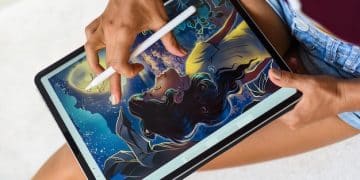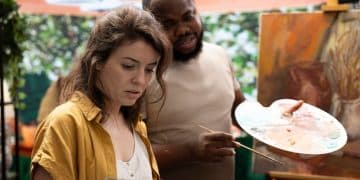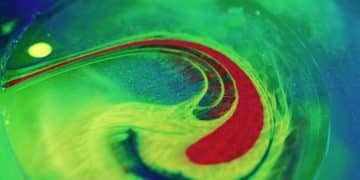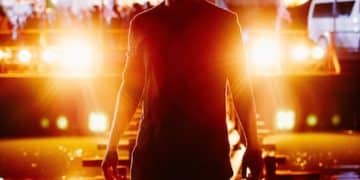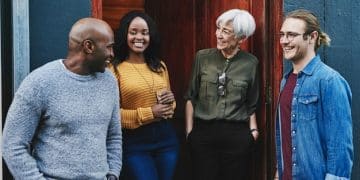Decoding AI’s Impact on US Artistic Expression: A Deep Dive
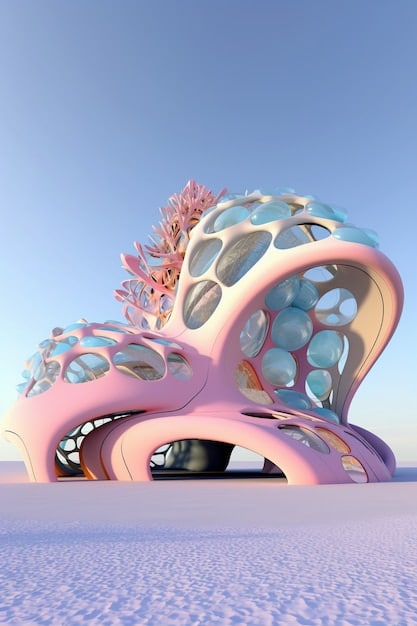
Decoding the impact of AI-generated content on artistic expression in the US reveals a complex interplay of innovation, copyright concerns, and the evolving definition of human creativity, challenging established norms and fostering new artistic possibilities.
The rapid evolution of artificial intelligence has sparked widespread debate across various sectors, and the arts are no exception. Decoding the impact of AI-generated content on artistic expression in the US involves navigating a landscape reshaped by technology, where machines are increasingly capable of creating works that challenge traditional notions of authorship and originality. This intricate discussion requires a nuanced understanding of both the opportunities AI presents and the significant challenges it poses to artists, industries, and legal frameworks.
The advent of AI in art: a new creative frontier
Artificial intelligence has transcended the realm of science fiction, embedding itself firmly in artistic creation. From generating complex musical compositions to crafting intricate visual art and compelling narratives, AI tools are redefining the boundaries of what is considered “art.” This innovation brings a fresh perspective, allowing artists to explore novel forms and push creative limits in unprecedented ways.
The ability of AI to process vast datasets and learn patterns from existing artworks enables it to serve as both a muse and a collaborator. Artists can leverage AI to overcome creative blocks, experiment with styles, or even as an entirely new medium. This integration has, in some cases, democratized art creation, making sophisticated tools accessible to a broader audience that previously lacked the technical skills for certain art forms.
AI as a tool for artistic exploration
Many artists in the US are embracing AI not as a replacement, but as an advanced tool. This ranges from using AI to automate repetitive tasks, freeing up more time for conceptual development, to employing generative models to create unique textures, patterns, or soundscapes that would be impossible or exceedingly difficult to achieve through traditional means.
- AI algorithms can analyze vast artistic movements and stylistic elements, offering artists a rich palette for inspiration.
- Generative adversarial networks (GANs) allow the creation of images, music, or text that mimic human-created work, providing a foundation for artists to adapt and refine.
- Interactive AI systems facilitate dynamic creative processes, where the artist and AI continually influence each other’s output.
The collaborative potential is immense. Imagine a musician feeding an AI a simple melody, and the AI returning a fully orchestrated piece, which the musician then refines. Or a painter using AI to generate countless iterations of a landscape, picking elements from each to form a final, cohesive vision. These scenarios highlight how AI can augment human creativity without necessarily supplanting it.
However, the ease of creation also sparks questions about artistic authenticity. If an AI generates a piece, where does the human touch truly lie? This debate is central to understanding AI’s full impact. As AI models become more sophisticated, distinguishing between human and machine-generated art becomes increasingly challenging, leading to important discussions about perception and value within the art market.
The conversation around AI in art in the US is dynamic, reflecting a society grappling with technological advancement and its implications for cultural heritage. It’s not just about what AI can do, but how it changes our relationship with the creative process itself.
Copyright conundrums: who owns AI-generated art?
The integration of AI into artistic production has ignited a complex debate surrounding copyright ownership, particularly in the US. Traditional copyright law is predicated on the concept of human authorship, granting rights to creators of original works. However, when an AI system generates content, the question of who holds the copyright becomes murky.
The US Copyright Office has generally maintained that human authorship is a prerequisite for copyright protection. This stance suggests that purely AI-generated works, without significant human intervention and creativity, may not be eligible for copyright. This interpretation poses considerable challenges for artists, developers, and companies investing in AI art solutions.
Legal frameworks and the definition of authorship
Currently, the legal landscape struggles to accommodate AI-generated output. Courts and lawmakers are grappling with how to adapt existing laws to a technology that can create without direct human input at every stage. This issue touches on fundamental definitions of “work” and “author.”
- Some argue that the human who conceptualized the AI, trained it, or curated its output should be considered the author.
- Others contend that if the AI autonomously generates unique expressions, it should perhaps be recognized as a creator, though this idea faces significant philosophical and legal hurdles.
- There’s also the question of whether the output of an AI, trained on copyrighted material, constitutes a derivative work or a new creation.
The implications for artists are profound. If AI-generated elements in their work are deemed uncopyrightable, it could diminish the commercial value and protective rights associated with their creations. This ambiguity might deter investment and innovation in AI art, or conversely, lead to a wave of open-source, unprotectable art.
Moreover, the ethical considerations of training AI on existing copyrighted works without explicit permission from the original artists are a major concern. Lawsuits are emerging, challenging the use of vast datasets of human-created art to train AI models, raising questions about fair use, compensation, and the potential for AI to devalue human artistic labor.
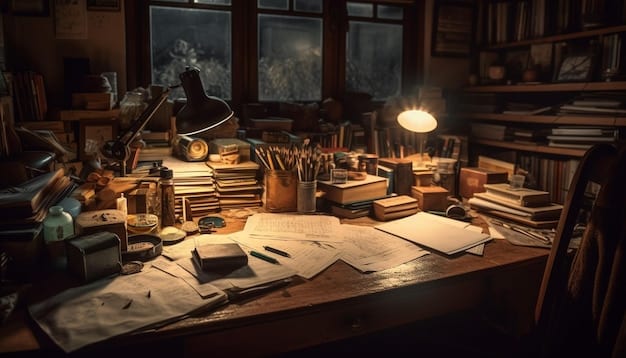
The ongoing legal wrangling highlights a critical need for updated legislation or new legal precedents that address the unique nature of AI. Without clear guidelines, the creative industries in the US risk a period of uncertainty and potential disputes over intellectual property, stifling the very innovation AI promises to deliver.
Ultimately, the resolution of these copyright conundrums will significantly shape the future of artistic expression in the US, influencing how artists collaborate with AI, how their works are valued, and how the fruits of technological advancement are shared and protected.
The challenge to traditional art forms and markets
The influx of AI-generated content presents a significant challenge to traditional art forms and established art markets in the US. Artists who have honed their craft over years, relying on traditional techniques and mediums, now face a landscape where machines can produce similar or even unprecedented works with remarkable speed and efficiency. This shift prompts difficult questions about the value of human skill, the definition of authenticity, and the economic viability of traditional artistic careers.
Many traditional artists fear that AI could devalue their work, leading to a saturation of the market with inexpensive or free AI-generated alternatives. The unique selling points of human art—the emotional depth, the personal narrative, the palpable skill—are being re-evaluated in the face of AI’s capabilities.
Redefining authenticity and value
One of the most profound impacts of AI on the art market is the redefinition of authenticity. For centuries, the artist’s touch, their unique handprint, has been central to an artwork’s value. With AI, this direct human connection can be diffuse or entirely absent, leading buyers and critics to question what makes a piece genuinely “authentic.”
- The perceived value of AI art often differs from that of human-created art, with debates focusing on intrinsic artistic merit versus the novelty of the technology.
- Galleries and collectors are beginning to grapple with how to categorize, display, and price AI art, considering its origins and the level of human input involved.
- The market for unique, human-crafted pieces may become a niche luxury, while AI-generated art could dominate more mainstream or commercial applications.
This challenge extends to the economic livelihoods of artists. If AI can produce compelling stock photography, design elements, or even illustrative work at a fraction of the cost, freelance artists and commercial creatives could see their opportunities diminish. The conversation isn’t just about whether AI can make art, but whether human artists can continue to make a living doing so.
Some artists are finding ways to adapt, integrating AI into their workflows as a tool to enhance their existing practices, rather than allowing it to replace them. This adaptation often involves a degree of digital literacy and a willingness to step outside traditional comfort zones. The art market will likely bifurcate, with distinct segments for purely human-made art and hybrid or AI-generated works, each with its own valuation metrics.
Ultimately, the art world in the US is at a crossroads, forced to confront how technology reshapes not only what art is, but also how it is produced, consumed, and valued in society.
New opportunities for artistic innovation and collaboration
Despite the challenges, AI also unlocks unprecedented opportunities for artistic innovation and collaboration, pushing the boundaries of what’s possible in creative expression. Artists in the US are increasingly discovering that AI isn’t solely a competitor but can be a powerful partner, enabling them to create works that were previously unimaginable. This collaborative paradigm fosters new genres, techniques, and interactive experiences.
AI’s capacity to process and analyze vast amounts of data—from art historical archives to real-time environmental sensors—allows artists to engage with information and patterns in profoundly new ways. This can lead to art that is more data-driven, interactive, or responsive to its environment, creating immersive and dynamic experiences for audiences.
The rise of AI-assisted creativity
Many artists are adopting AI as an assistant, a co-creator, or an enabler. This can range from algorithms that help brainstorm ideas and generate initial concepts to systems that participate in real-time performances or installations. The beauty of this approach lies in the synergy between human intuition and AI processing power.
- AI can generate endless variations of a theme, allowing artists to explore ideas quickly and efficiently before settling on a direction.
- Complex generative music or visual patterns can be created, which might involve too many variables for a human to manage without assistance.
- Interactive art installations can be made more responsive to audience participation or environmental stimuli through AI’s real-time analytical capabilities.
This new form of collaboration often leads to art that blurs the lines between creator and tool, challenging viewers to consider the nature of artistic intent. For example, AI-powered systems can produce music that adapts to a listener’s mood, or visual art that continuously evolves based on social media sentiment, creating highly personalized and ephemeral experiences.
Moreover, AI is fostering interdisciplinary collaborations, bringing together artists with technologists, scientists, and engineers. This convergence often results in hybrid art forms that combine traditional aesthetics with cutting-edge computational methods, producing works that are conceptually rich and technically ambitious. These projects often receive grants and funding from tech companies and cultural institutions keen to explore the vanguard of artistic innovation.

The openness to experimentation and the willingness to explore uncharted creative territories define this new era. Artists are not passively accepting AI’s presence but actively engaging with it, shaping its use and demonstrating its potential to expand, rather than diminish, the scope of human artistic expression in the US.
The ethical landscape: bias, representation, and exploitation
As AI-generated content becomes more prevalent in artistic expression within the US, a critical ethical landscape emerges, fraught with concerns about bias, representation, and potential exploitation. AI models are trained on vast datasets, and if these datasets reflect existing societal biases—racial, gender, cultural, or otherwise—the AI’s output can perpetuate or even amplify these biases, leading to problematic artistic creations.
This raises serious questions about who controls the narratives and aesthetics generated by AI, and whether these systems truly represent the diverse tapestry of artistic expression or merely reinforce dominant cultural perspectives. The “black box” nature of some AI algorithms further complicates accountability and transparency.
Addressing inherent biases in AI models
The issue of bias in AI is not merely theoretical; it has tangible impacts on representation. For instance, if an AI is trained predominantly on art created by a specific demographic or cultural group, it might subsequently generate art that largely ignores or misrepresents others. This can lead to a lack of diversity in AI-generated art, potentially alienating audiences and perpetuating stereotypes.
- Developers and artists must critically examine the datasets used to train AI art models for any inherent biases.
- Efforts are needed to curate more diverse and inclusive training data to ensure AI outputs reflect a broader range of human experiences and aesthetics.
- Mechanisms for identifying and mitigating bias in AI-generated content are essential to promote fairness and equitable representation.
Beyond bias, there’s the concern of exploitation, particularly regarding artists whose works are used, often without their explicit consent or compensation, to train AI models. This practice can be seen as a form of unpaid labor and intellectual property infringement, undermining the economic stability of human artists.
The potential for AI to be used to create deepfakes or manipulate artistic images and videos also raises ethical alarms, particularly in the realm of misinformation and reputation damage. The ease with which AI can generate convincing, yet fabricated, content demands careful consideration of its responsible use.
For the US art community, navigating this ethical terrain requires open dialogue, robust policy discussions, and a commitment to developing AI responsibly. It’s about ensuring that as AI expands artistic capabilities, it does so in a way that is equitable, transparent, and respectful of all creators and cultures.
Impact on art education and future generations of artists
The emergence of AI-generated content is profoundly impacting art education and, consequently, the future generations of artists in the US. Art schools, universities, and independent programs are now confronted with the challenge of integrating AI tools and concepts into their curricula, while also preserving foundational artistic skills and critical thinking. This balancing act is crucial for preparing students for an evolving art world where AI will play an increasingly prominent role.
Educators are exploring how to teach students not just to use AI, but to understand its underlying principles, its ethical implications, and its potential for both creative enhancement and disruption. The focus is shifting from merely mastering traditional techniques to cultivating adaptability, technological literacy, and a nuanced understanding of human-AI collaboration.
Reshaping curricula and teaching methodologies
Traditional art education has often emphasized manual dexterity, observational skills, and conceptual development rooted in personal expression. With AI, art students now need to add computational thinking, algorithm literacy, and data ethics to their toolkit. This necessitates a significant reshaping of curricula and teaching methodologies.
- Art programs are introducing courses on AI art generation, computational creativity, and digital ethics relevant to AI.
- Emphasis is placed on critical analysis of AI-generated content, encouraging students to question authorship, authenticity, and the societal impact of their AI-assisted creations.
- Collaboration with computer science and engineering departments is becoming more common, fostering interdisciplinary learning experiences.
The discussion in art academies often revolves around finding the sweet spot: how can students leverage AI’s power without diluting their unique artistic voice or compromising their commitment to original thought? This involves teaching responsible AI use, encouraging experimentation, and fostering an environment where AI is seen as a means to an end, not an end in itself.
Future artists will likely be those who can effectively blend human intuition and emotion with AI’s analytical and generative capabilities. They will be adept at prompt engineering, capable of guiding AI to produce specific artistic outcomes, and skilled in refining and personalizing AI-generated content to infuse it with their unique identity. This isn’t just about using a new tool; it’s about evolving the very definition of what it means to be an artist.
The challenge for art education is to cultivate resilience and foresight in students, preparing them not just for the art world of today, but for a future art world that is continuously being redefined by technological advancements. By embracing AI constructively, art education in the US can equip the next generation with the skills to lead and innovate within this exciting new creative landscape.
The future of human creativity in an AI-driven world
As AI continues to mature and its presence in artistic creation deepens, a fundamental question emerges: what is the future of human creativity in an AI-driven world? This isn’t a question of whether human creativity will disappear, but rather how it will transform and adapt within a technologically advanced landscape. The consensus among many artists and thinkers in the US is that human creativity will become even more vital, albeit in new forms.
AI’s ability to automate repetitive tasks and generate vast quantities of content could free human artists to focus on higher-level conceptualization, emotional resonance, and the unique human experience that AI, at present, cannot replicate. Creativity may shift from purely execution-based to a more curatorial or directive role, influencing AI’s output and imbuing it with distinct human intent.
Evolving roles for the human artist
The human artist of the future may assume several evolving roles. They could become masterful “prompt engineers,” capable of articulating precise creative visions for AI to execute. They might also become “AI whisperers,” understanding the nuances of different algorithms to elicit specific styles or moods. Furthermore, the role of the artist as an editor, selector, and refiner of AI-generated content will be crucial, ensuring that the final output resonates with human sensibility and purpose.
- Artists will increasingly focus on defining the ‘why’ and ‘what’ of art, leaving the ‘how’ to AI in many instances.
- The emphasis will be on emotional intelligence, ethical considerations, and crafting narratives that connect deeply with human audiences.
- Human artists will provide the critical discernment and subjective judgment necessary to transform raw AI output into meaningful art.
Moreover, the distinctiveness of human-error and imperfection, often seen as intrinsic to a piece’s charm and authenticity, might become even more valued. In a world saturated with technically perfect AI creations, the deliberate imperfections, the emotional undertones, and the personal struggles embedded in human-made art could stand out as hallmarks of true human expression.
The future may also see a stronger push towards live, ephemeral, and interactive art forms where human presence and real-time improvisation remain central. Performances, immersive installations, and community-driven art projects provide experiences that are difficult for AI to fully replicate, reinforcing the unique value of human-to-human connection in art.
Ultimately, the human spirit of ingenuity and expression is resilient. While AI will undoubtedly transform the landscape of artistic creation, it will also compel artists to explore new facets of their own creativity, redefining their purpose and methods in a symbiotic relationship with technology. The future of human creativity in the US appears not to be replaced by AI, but rather augmented, challenged, and ultimately, deepened by it.
| Key Point | Brief Description |
|---|---|
| 🤖 AI as a Tool | AI expands creative possibilities and aids artists in generating ideas and unique forms. |
| ⚖️ Copyright Challenges | Uncertainty surrounds ownership and protection for AI-generated artistic works under US law. |
| 📚 Art Education Shift | Curricula are adapting to integrate AI literacy, ethics, and human-AI collaboration skills. |
| 🎨 Future of Creativity | Human creativity will evolve, focusing on conceptualization and unique emotional depth. |
Frequently asked questions about AI and artistic expression
While AI can generate sophisticated and aesthetically pleasing content, many argue that it lacks consciousness, intent, and personal experience, which are hallmarks of human artistry. AI serves more as a tool or collaborator, extending human creative capabilities rather than acting as an autonomous artist.
Key ethical concerns include potential biases in AI outputs due to biased training data, questions of data privacy and the exploitation of artists whose work is used for training without consent, and the challenge of establishing clear authorship and intellectual property rights in AI-assisted creations.
US copyright law currently requires human authorship for protection. This means purely AI-generated works without significant human intervention may not be copyrightable. The legal framework is still evolving, with ongoing debates and litigation shaping future policies and interpretations for hybrid human-AI creations.
Most experts believe AI will not replace human artists but will rather augment and transform their roles. AI can automate tedious tasks and open new avenues for expression, allowing artists to focus on conceptualization, critical thinking, and infusing their work with unique emotional depth and personal narratives that AI cannot replicate.
Artists can use AI for brainstorming, generating diverse iterations of ideas, exploring new aesthetic styles, and automating repetitive elements. By learning prompt engineering and understanding AI’s capabilities, artists can leverage these tools as powerful assistants, expanding their creative reach and efficiency.
Conclusion
Decoding the impact of AI-generated content on artistic expression in the US reveals a multifaceted and evolving narrative. It is clear that AI is not merely a passing technological fad but a transformative force reshaping how art is conceived, created, valued, and taught. While challenges surrounding copyright, authenticity, and ethical biases are significant and demand careful consideration, the opportunities for innovation, collaboration, and the expansion of human creativity are equally profound. The future of artistic expression will likely involve a dynamic interplay between human ingenuity and artificial intelligence, pushing artists to redefine their roles and embrace a new era of creative possibilities.
